Columns

| a game by | Sega |
| Genres: | Arcade Classics, Puzzles & Words, Strategy/War |
| Platforms: |
|
| Editor Rating: | 6.2/10, based on 9 reviews, 10 reviews are shown |
| User Rating: | 7.0/10 - 2 votes |
| Rate this game: | |
| See also: | Columns Games |
Prepare to journey through time with the ancients to a place where magical jewels tumble from the skies. When you reach this mystic gem show you'll face a challenge that requires quick reflexes, intuition, and steady nerves. With practice you'll be ready to take on the ancients themselves.
Match and Catch
Welcome to the world of Columns, an arcade title that's now the first Tetris-style puzzler available for the Genesis. From the moment the first bewitching strains of music twine around your brain cells, you'll find this game is very hard to put down.
As the game begins, sets of three jewels in vertical columns come drifting down from the top of the screen. Your task is to stack the jewels in such a way that they form horizontal, vertical, or diagonal rows of the same color. As each column falls you can move it to the left or the right and change the order of the jewels in the column.
ProTip: When a column appears that has two Jewels of the same color you should first check if you have a third jewel to match them and if not, quickly switch the similarly colored jewels to me top of the column so they're easily accessible for a match.
Once a column lands you have two last chances to quickly change the order of the jewels. When you create a row of jewels of the same color, they vanish, you score points, and the other jewels in your stack shift and drop into the openings left by the vanished jewels. Sometimes this creates a chain reaction of vanishing jewels.
As you reach higher levels a set of Wild Card Tiles may appear. Quickly scan your screen to see which color jewel you have the most of. Guide the magic jewels to land on this color and ah the jewels of the color vanish from the screen!
As more and more jewels drop you reach higher levels and the game becomes more difficult as the jewels drop faster and faster. Your game ends of the stack of jewels reaches the top of the screen.
- Always try to drop jewels in such a way as to keep your stack as low as possible. As your stack gets higher you have less and less time to react in order to place your jewels.
- Once you've got the hang of the game try to keep an eye on the window at the top of the screen that previews the next set of three jewels. By the time a column appears on the screen, you should already know where you're going to put it.
Columns for Two
Columns also includes several different game options to make it even more entrancing. In the Arcade Mode one or two players can go head-to-head or-play completely independently at easy, medium, or hard levels of play. The game tracks the number of jewels dropped, the point score, and the level reached -- so compete any which way you like.
For a more strategic style of play try setting the game to Difficult and then pausing it as the columns appear on screen. You can take your time deciding where to place the jewels, which makes for a different game.
In the Original Mode (which is easier than the Arcade Mode) one or two players can compete head-to-head or try doubles, where players take turns placing the jewels. This mode also enables you to select difficulty, pick levels, and even create a time trial situation. There are also three different ancient melodies to lull you into the appropriate state of mind.
It may take a while for Columns to reel you in. There's much more to the game than initially meets the eye. Graphically the game is simple, but the sound and the playability are excellent. Check it out in the arcades and you'll see that Columns definitely stacks up!
Download Columns

System requirements:
- PC compatible
- Operating systems: Windows 10/Windows 8/Windows 7/2000/Vista/WinXP
- Game modes: Single game mode
Player controls:
- Up, Down, Left, Right - Arrow keys
- Start - Enter (Pause, Menu select, Skip intro, Inventory)
- "A" Gamepad button - Ctrl (usually Jump or Change weapon)
- "B" button - Space (Jump, Fire, Menu select)
- "C" button - Left Shift (Item select)
Use the F12 key to toggle mouse capture / release when using the mouse as a controller.

System requirements:
- PC compatible
- Operating systems: Windows 10/Windows 8/Windows 7/2000/Vista/WinXP

System requirements:
- PC compatible
- Operating systems: Windows 10/Windows 8/Windows 7/2000/Vista/WinXP
Game Reviews
Columns, the latest of the dozens of Te-tris-inspired games, offers a few variations on the original. True, it doesn't offer as many as Klax, another Tetris variant for the Genesis. But then, Klax might be a little too different for Tetris fans who can't buy the Soviet puzzle game for their Genesis systems and want the next best thing.
Columns sticks much closer to the proven formula. Colored objects gradually fall from the top of the screen, and you have to arrange them in patterns at the bottom of the screen to make them disappear. The longer you can keep the objects from piling up to the top of the screen, the longer the game lasts and the more points you score.
But unlike the variety of geometric shapes that descend in Tetris, the falling objects in Columns are all the same shape — vertical columns made of three colored blocks. You can't rotate these objects as you can in Tetris, but you can change the position of the colored blocks within each column. And unlike Tetris, your goal isn't to form unbroken horizontal rows across the bottom of the screen, but rather to form matching rows of colored blocks. When you line up three or more blocks of the same color vertically, horizontally, or diagonally, they disappear and you get points.
If any blocks are stacked atop the ones that disappeared, they'll fall downward to fill the gaps. Sometimes this triggers a chain reaction — new rows of matching blocks are formed, then disappear, thus causing more blocks to fall, and so forth. There's also a "wild card" column that eliminates all blocks of whatever color it lands on.
Basically, that's it. Columns does offer a few variations on the standard game, though. Two people can play simultaneously, and another mode lets you race against a timer while trying to uncover a flashing block buried beneath regular blocks at the bottom of the screen. Perhaps the best new feature of Columns is the background music. You can choose from three different tunes, all much better than the average videogame soundtrack.
In short, Columns holds few surprises. It won't win any points for massive originality, but if you want to play Tetris on your Genesis, this is as close as you're likely to get.
The smash Japanese arcade hit is being translated for the Genesis system. Similar in concept to Tetris, in Columns you must match up colors rather than shapes. Match three of the same color horizontally, vertically or diagonally and they disappear. Match up four and get big bonus points. If you don't like the order of the colors in the block which is falling you can change the order in which they appear. Play alone or against a friend.
Sega is bringing out a Tetris-like falling piece puzzle game. In this, all of the pieces are the same shape. On each piece though, there are three jewels and each jewel could be one of several different colors. As the piece falls you can change the order of the colors. When you match up at least three of the same color either horizontally, vertically or diagonally the jewels disappear and the remaining pieces fall downward.
People say:
The 8-Bit version of Columns misses in several areas. While the game itself does induce the Tetris-like falling puzzle game, the shapes are too small. The game is also much too easy. Both are minor shortcomings that detract from a good design.
Most puzzle games aren't memory hogs. The Genesis version is only 1 meg and why Sega couldn't make a nice looking SMS version is beyond me. The playfield is too small and it the NES Tetris can look good why can't the SMS Columns? Still worth trying if you don't have a Genesis.
Columns is a great game on the Genesis and in the arcades but the SMS version is lacking in graphics and game play. The gems are way too small and the colors seem to blur together making it difficult to play. Not bad, but not great.
What is already a small playfield has been further deduces to the point of no return! I really like this game! Just not this version! A great coin-op game, but suffers here due to poor execution! Execution,,,hmmm... not a bad idea for this version.
- Manufacturer: SEGA
Many say that there was an ancient Phoenician game where six kinds of exotic jewels fell from the sky. When three or more of the same kind of jewel were lined up, they would magically disappear. Well, Sega has brought this legendary game to the arcades in the form of Columns.
Using a joystick and a button, you'll control a vertically aligned set of three jewels as they fall from the top of the screen. Pressing the button will let you shuffle the three jewels as you attempt to line up three or more horizontally, vertically or diagonally at the bottom of the screen. Once you have made a match, the jewels will mysteriously flash and disappear.
Thankfully, the game gives you some time to attempt matches, because even after the pieces drop, you can move and/or shuffle for a second or so.
Using this strategy, you can correct previous mistakes by sliding jewels into matches. You may even cause a chain reaction. This can happen after a match is made, because the disappearance of some sets of jewels may cause others to fill in the blank spaces, possibly resulting in more matches. This is usually done more by accident than by skill - at least in my case that was true.
To add some spice to this strategy game, there is a special jewel that sometimes appears in the medium and difficult levels of the game. This jewel changes colors and is basically a wild card - similar to the wild file in Wax - allowing you to complete a match where you normally might not have been able to.
There isn't much to Columns graphically or in the way of animation, but that is generally the nature of strategy games. What graphics and animation are present, however, are used effectively to enhance the pleasure of the game. While the object of the game is to eliminate as many jewels as possible, your game will end if the jewels reach the top. And that seems to happen all too quickly for me, because the pace at which the pieces fall picks up drastically after you begin. It leaves me with this conclusion: if you had an easy time with the arcade version of Tetris, which left other arcade-goers gaping, then Columns is the game for you.
- Machine: Sega Genesis
Columns, the latest of the dozens of Tetris-inspired games, offers a few variations on the original. True, it doesn't offer as many as Klax, another Tetris variant for the Genesis. But then, Klax might be a little too different for Tetris fans who can't buy the Soviet puzzle game for their Genesis systems and want the next best thing.
Columns sticks much closer to the proven formula. Colored objects gradually fall from the top of the screen, and you have to arrange them in patterns at the bottom of the screen to make them disappear. The longer you can keep the objects from piling up to the top of the screen, the longer the game lasts and the more points you score.
But unlike the variety of geometric shapes that descend in Tetris, the falling objects in Columns are all the same shape - vertical columns made of three colored blocks. You can't rotate these objects as you can in Tetris, but you can change the position of the colored blocks within each column. And unlike Tetris, your goal isn't to form unbroken horizontal rows across the bottom of the screen, but rather to form matching rows of colored blocks. When you line up three or more blocks of the same color vertically, horizontally, or diagonally, they disappear and you get points.
If any blocks are stacked atop the ones that disappeared, they'll fall downward to fill the gaps. Sometimes this triggers a chain reaction - new rows of matching blocks are formed, then disappear, thus causing more blocks to fall, and so forth. There's also a "wild card" column that eliminates all blocks of whatever color it lands on.
Basically, that's it. Columns does offer a few variations on the standard game, though. Two people can play simultaneously, and another mode lets you race against a timer while trying to uncover a flashing block buried beneath regular blocks at the bottom of the screen.
Perhaps the best new feature of Columns is the background music. You can choose from three different tunes, all much better than the average videogame soundtrack.
In short, Columns holds few surprises. It won't win any points for massive originality, but if you want to play Tetris on your Genesis, this is as close as you're likely to get.
Columns has found it way through many systems and now it is on the Game Gear. This puzzle game will challenge your mind for hours and hours.
- Levels: 16
- Theme: Puzzle
- Players: 1-2
- Difficulty: Average
Sega's strategy based game follows the same lines as Tetris except Columns is not a linear game as you can match up colors on a diagonal! As you proceed, the blocks fall faster.
- Type: Puzzle
- Release: Sep. 1990
- Levels: 16
- Difficulty: Easy
Sega's version of a Tetris-type puzzle game. In this all the pieces are the same size and shape but they contain three jewels which could be of different colors. As the piece drops downward you can switch the sequence of the jewels on the piece in order to get three or more jewels of the same color to line up either vertically, horizontally or diagonally. The matched pieces disappear, and the rest drop downward.
People say:
Columns is the first attempt by Sega to reproduce the action and strategy of a Tetris-style game for the Genesis. The game is unique and plays good, but it's not in the same league as Tetris. A nice diversion with the usually well-rounded 16-Bit features, but not incredible.
A fantastic game that is just different enough from Tetris to develop it's own following. It is better than Tetris in that you have to think in more than just the typical horizontal and vertical directions. By adding diagonal matches throws in a third dimension!
Columns is a decent falling-shape puzzle game with a Klax-inspired twist. The speed and execution of the game are good, but the theme gets tiring after a while. It's more difficult to save yourself from mistakes, lending a bit of futility to the whole thing. Nice try.
A new diversion to the Tetris type theme, both colorful and satisfying to keep me coming back. Rotate and arrange different colored crystals in vertical, horizontal and diagonal formations of three of the same. Crystals dissolve faster than the value of the Yen! For blockheads only!
Tired of the same old shoot-em-ups? Seen one too many similar-looking baseball carts? Well, Master System fans, something completely different is about to fall your way. The name of the game is Columns, and if you like Tetris-style puzzlers, this is the best thing to come along for the SMS in many moons.
One Blink and You Lose
Although the action moves so fast you can't afford to blink your eyes, you'll find the concept of the game is relatively simple. You begin with a blank game board, but within seconds a set of three vertically-stacked objects call Blocks drops from the top of the screen. When it reaches the bottom of the screen another quickly follows. As the Blocks begin to stack up, your mission is to guide the sets down with the directional pad in such a fashion that you link at least three blocks of the same color together-either vertically, horizontally, or diagonally. Then, they disappear and you score points. As a set fells you can also rearrange the order of the Blocks with Button A and B. The major rule in the game is "don't let your blocks reach the top of the board." If they do you get the big "Game Over." The first few Blocks fall into place quite nicely, but don't let this apparent ease fool you. The fun begins as soon as the falling Blocks begin to pick up speed.
Try not to limit yourself just to three-Block matches. Go for four-and fiveway matches, too-the more you link together, the more points you rack up. Make a match that makes other matches when the Blocks drop down, and you might zap 20 or more Blocks at a time.
Columns For Two
Columns features some great variations that keep the action fresh and new. First of all, you can play with five types of Blocks-jewels, dice, fruit, playing card symbols, and plain ole' cubes.
If you're playing alone, try the Flash option. Here your mission is to dig deep into a pile of Blocks and uncover a flashing Block. You set the size of the pile, but be careful-it gets a lot harder the higher you pile the Blocks, and time is of the essense here.
For some hot two-player action try the Versus mode. You go head-to-head against a friend in either Normal or Rash game play. In Normal mode you're competing for score. In the Flash mode you try to beat your buddy to the flashing Block. If you knock out a set of Blocks, then the bottom of your opponent's stacks moves one step closer to the ceiling. Make a really hefty match, and you send your opponent sailing through the roof!
If you're into peaceful coexistence, check out Co-Operative play. Here you and a friend take turns placing the Blocks, trying to pump up the score and soar through the game's levels.
Columns Stacks Up Well
Warning: Once you get your hands on Columns you might not be able to put your controller down. The graphics and the sound aren't bad, but the addicting challenge is excellent! This is the best game to come out for the SMS in a long time.
ProTips:
- When playing Flash with a friend don't automatically go for the flashing Block. You can win Just as easily by sending your opponent through the roof.
- Since you stare at the screen for a long time, experiment. Some objects are easier to see than others.
- When the Blocks get to falling really fast you might not have time to glance at the display. Don't panic. Fi/lake a match and it takes the computer a few seconds to rub out the Blocks. Use that time to size up your next move!
- Occasionally, Just when you think the game's over, the computer drops a Magical Jewel. This happens during Level 0 and then every other three levels.











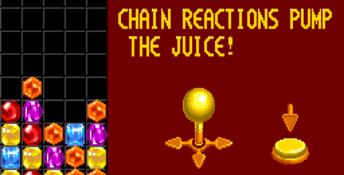
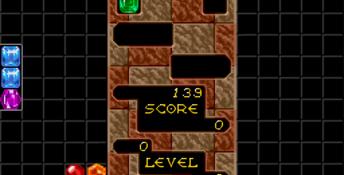






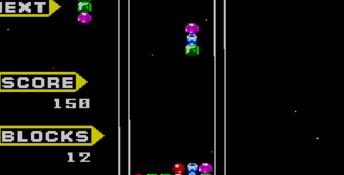




















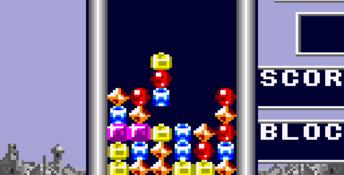



 Tetris Attack
Tetris Attack
 Wild Snake
Wild Snake Tetris 2
Tetris 2 Tetris Worlds
Tetris Worlds
 Super Tetris
Super Tetris
 Magical Tetris Challenge
Magical Tetris Challenge
 The Next Tetris: On-Line Edition
The Next Tetris: On-Line Edition Rock'n! Monster!!
Rock'n! Monster!!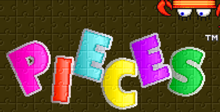 Pieces
Pieces
 Flipull
Flipull Boxy Boy
Boxy Boy
 Chew Man Fu
Chew Man Fu
 WildSnake
WildSnake IQ Remix +
IQ Remix +
 Pyramids of Ra
Pyramids of Ra Super Columns
Super Columns